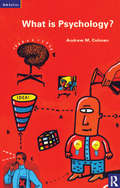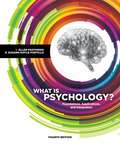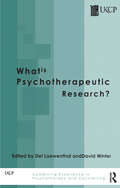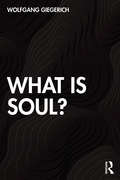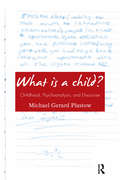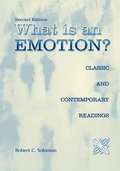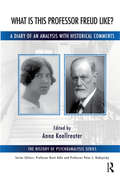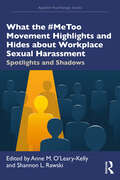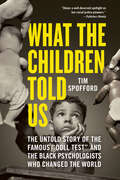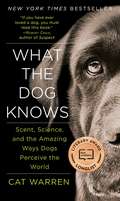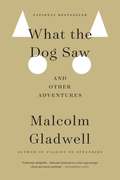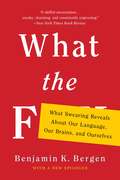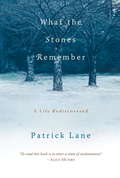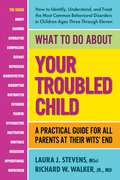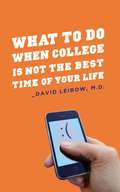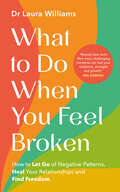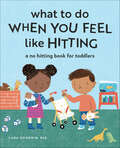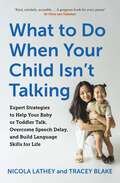- Table View
- List View
What is Psychology?
by Andrew ColmanThis clear and lively introduction to psychology assumes no prior knowledge of the subject. Extensively revised and updated, this third edition describes psychology as it is taught at universitues. Examples are used throughout to illustrate fundamental ideas, with a self-assessment quiz focusing readers' minds on a number of intriguing psychological problems. The differences betwen psychology, psychiatry and psychoanalysis are explained, and the professions and careers associated with psychology are explored. Suggestions for further reading and useful internet sites are included.
What is Psychology?: Foundations, Applications, and Integration
by Ellen E. Pastorino Susann M. Doyle-PortilloWHAT IS PSYCHOLOGY? FOUNDATIONS, APPLICATIONS, AND INTEGRATION includes some of the most effective features from Pastorino and Doyle-Portillo's other texts, as well as new and innovative features to excite students about the field of psychology. The text is organized around the foundational areas of psychology emphasized in the latest version of the APA guidelines. It incorporates the authors' successful and engaging teaching approach, which motivates students to read and captures their curiosity from the very beginning. The parts open with attention-grabbing case studies that have drawn rave reviews from students. Each case study is threaded throughout all of the chapters of the section, providing students with a view of the content that is both integrated and applied to real life.
What is Psychotherapeutic Research? (Ukcp Karnac Ser.)
by Del Loewenthal David WinterThis book marks an important watershed in the development of psychotherapy. It provides examples of how psychotherapeutic research and the abilities to carry it out can help the practising psychotherapist. A lack of relative knowledge of research in psychotherapy, a history of apparent defensiveness is being evaluated, and a reluctance to work with universities has developed in psychotherapy. The papers represent a cross-section of current research thinking from within the UKCP, North America and Continental Europe. It will prove useful for students and practitioners of psychotherapy, as well as those more traditionally engaged in psychotherapeutic research.The book has been divided into five sections: Section One outlines what is meant by psychotherapeutic research and gives an overview of the features of different research methods. Section Two describes how to get started in the use of qualitative and quantitative methods. Section Three focuses on research into the process of psychotherapy.
What is Soul?
by Wolfgang GiegerichRooted in the metaphysics of bygone times, the notion of soul in our Western tradition is packed with associations and meanings that are incompatible with the anthropological and naturalistic thinking that prevails in modernity. Whereas treatises of old conceived of the soul as an infinite, immaterial substance which was the ground of man’s hope for eternal salvation, modern psychology has for the most part discarded the concept in favor of more tangible touchstones such as the emotions, desires, and attachments which characterize man as a finite, bodily-existing positive fact. An exception to this trend has been the analytical psychology of C. G. Jung. Against the positivistic spirit of his times, Jung insisted upon a "‘psychology with soul,’ that is, a psychology based upon the hypothesis of an autonomous mind." In this volume, Wolfgang Giegerich once again takes up the Jungian commitment to a psychology with soul. Agreeing with Jung that the soul concept is indispensable for a truly psychological psychology, he supplements and re-orients the Jungian approach to both this concept and the phenomenology of the soul by means of a whole series of nuanced discussions that are as rigorous as they are thoroughgoing. The result is nothing short of a tour de force. Tarrying with the negative, Giegerich’s particular contribution resides in his showing the movement against the soul to be the soul’s own doing. In animus moments of itself, consciousness in the form of philosophy and Enlightenment reason turned upon itself as religion and metaphysics. Far from abolishing the soul, however, these incisive negations were themselves negated. As if dancing upon its own demise, the soul came home to itself, not as an invisible metaphysical substance, but more invisibly still as the logically negative evaporation of that substance into the form of subject, or even better said, into psychology.
What is This Thing Called Love?: A Guide to Psychoanalytic Psychotherapy with Couples
by Sarah Fels UsherWhat is This Thing Called Love? provides a clear how-to guide for carrying out psychotherapy with couples from a psychoanalytic perspective. The book draws on both early and contemporary psychoanalytic knowledge, explaining how each theory described is useful in formulating couple dynamics and in working with them. The result is an extremely practical approach, with detailed step-by-step instructions on technique, illuminated throughout by vivid case studies. The book focuses on several key areas including: An initial discussion about theories of love. Progression of therapy from beginning to termination. Transference and countertransference and their unique manifestations in couples therapy. Comparisons between couples therapy and individual therapy. Step-by-step instruction on technique. What is This Thing Called Love? is enlivened with humour and humanness. It is crucial reading for psychoanalytic therapists, psychologists, psychiatrists, couples therapists and students who want to learn about--or augment their skills in--this challenging modality.
What is Wisdom and Can it be Taught?: Philosophical, Psychological, and Pedagogical Perspectives (Advances in Theoretical and Philosophical Psychology)
by Päivi Tynjälä Eeva K. KallioWhat is Wisdom and Can it be Taught? uses careful theoretical analysis and a well-argued ontological conception of the human being to present a new ‘Holistic Wisdom Model’, summarizing existing research and presenting fresh insights.Human wisdom is a complex phenomenon. Psychological research in this area has led to a wide range of fragmentary claims and models, and therefore, there is a need for theoretical clarification of the field: What is wisdom? How should we study it in the first place? Is it a purely psychological phenomenon, or do we also need philosophy? This book examines these questions, as well as provides a pedagogical review of wisdom to evaluate how people become wise(r) and whether wisdom can be taught. Drawing on findings from a range of educational fields, it shows the crucial features of wisdom-enhancing pedagogies we already know, which are summarized in a ‘Teaching for Wisdom Model’.Written by leading, interdisciplinary scholars, this book illuminates the study of wisdom for researchers, academics, teachers, and students of psychology, philosophy, and education.
What is a Child?: Childhood, Psychoanalysis, and Discourse
by Michael Gerard PlastowThis book unravels the different notions of time and history that are implicit in the history of child psychoanalysis and in the clinical approach to childhood. It is based, in part, on topics that have been addressed in the seminar Psychoanalysis and the Child.
What is an Emotion?: Classic and Contemporary Readings
by Robert C. SolomonWhat is an Emotion?, 2/e, draws together important selections from classical and contemporary theories and debates about emotion. Utilizing sources from a variety of subject areas including philosophy, psychology, and biology, editor Robert Solomon provides an illuminating look at the "affective" side of psychology and philosophy from the perspective of the world's great thinkers. Part One of the book features five classic readings from Aristotle, the Stoics, Descartes, Spinoza, and Hume. Part Two offers classic and contemporary theories from the social sciences, presenting selections from such thinkers as Charles Darwin and Sigmund Freud alongside recent work from Paul Ekman, Catherine Lutz, and others. Part Three presents some of the extensive work on emotion that developed in Europe over the past century. Part Four includes essays representing the discussion of emotions among British and American analytic philosophers. The volume is enhanced by a comprehensive introduction by the editor and a multidisciplinary bibliography. What is an Emotion? is appropriate for any course in which the nature of emotion plays a major role, including philosophy of emotion, philosophy of mind, history of psychology, emotion and motivation, moral psychology, and history and psychology of consciousness courses. The second edition provides much more material on emotions in the sciences and more from recent philosophical theories, encompassing recent shifts in theorizing on three fronts: the wealth of new information on the central nervous system and the brain; new developments in cross-cultural research and anthropology; and the recent emphasis on "cognition" in emotion, both in philosophy and the social sciences. New selections include work by Antonio Damasio, Ronald De Sousa, Paul Ekman, Nico Frijda, Patricia Greenspan, Paul Griffiths, Richard Lazarus, Catherine Lutz, Martha Nussbaum, and Michael Stocker.
What is this Professor Freud Like?: A Diary of an Analysis with Historical Comments (The History of Psychoanalysis Series)
by Anna KoellreuterIn 1921, a young female doctor started analysis with Sigmund Freud. In a diary, she recorded what moved her. The present volume not only contains a full translation of these records, but also collects four essays by two psychoanalysts and two analytical historians who take their cue from the young doctor's notes to think about Freud and his methods. The discovery of the diary marks a small sensation for the history of social science. Three factors make the document unique: first, it records not a training analysis, but the analysis of an actual patient, second, the analysis took place before Freud fell ill with cancer, and third, the analysand obviously noted down what was said in the practice word by word.
What it Takes to Pull Me Through
by David L. MarcusThis is a book about a therapeutic boarding school for out-of-control teens.
What the #MeToo Movement Highlights and Hides about Workplace Sexual Harassment: Spotlights and Shadows (Applied Psychology Series)
by Anne M. O’Leary-Kelly Shannon L. RawskiWhat the #MeToo Movement Highlights and Hides about Workplace Sexual Harassment seeks to examine both the spotlights (Part I) and the shadows (Part II) of the #MeToo movement, setting a research agenda to examine both more carefully in management research.Sexual harassment (SH) is not a new phenomenon in organizations; it has been the topic of scholarly inquiry since the 1970s and has existed as a form of dysfunctional organizational behavior and abuse of power for much longer. Even so, the #MeToo movement thrust this organizational issue into the spotlight, raising new awareness and concern about an age-old problem, including digital forms of SH, bystander behavior, and organizational and societal ideas around masculinity and gender-based violence. At the same time, #MeToo kept other aspects of SH in the dark. Shadows addressed include the more mundane and common forms of low-severity micro-SH, how to help targets heal from trauma, the complex intersectional experiences of women of color, the experiences of male targets and those in low socioeconomic status jobs, and the implications of #MeToo on legal theory.Insights from #MeToo highlight the power of social movements to frame the public’s understanding of the issue of SH and to spark counter-movements that challenge that frame. This volume will be of interest to researchers, scholars, students, practitioners and policymakers.
What the Children Told Us: The Untold Story of the Famous "Doll Test" and the Black Psychologists Who Changed the World
by Tim SpoffordDoes racial discrimination harm Black children's sense of self?The Doll Test illuminated its devastating toll.Dr. Kenneth Clark visited rundown and under-resourced segregated schools across America, presenting Black children with two dolls: a white one with hair painted yellow and a brown one with hair painted black. "Give me the doll you like to play with," he said. "Give me the doll that is a nice doll." The psychological experiment Kenneth developed with his wife, Mamie, designed to measure how segregation affected Black children's perception of themselves and other Black people, was enlightening—and horrifying. Over and over again, the young children—some not yet five years old—selected the white doll as preferable, and the brown doll as "bad." Some children even denied their race. "Yes," said brown-skinned Joan W., age six, when questioned about her affection for the light-skinned doll. "I would like to be white."What the Children Told Us is the story of the towering intellectual and emotional partnership between two Black scholars who highlighted the psychological effects of racial segregation. The Clarks' story is one of courage, love, and an unfailing belief that Black children deserved better than what society was prepared to give them, and their unrelenting activism played a critical role in the landmark Brown v. Board of Education case. The Clarks' decades of impassioned advocacy, their inspiring marriage, and their enduring work shines a light on the power of passion in an unjust world.
What the Dog Knows: The Science and Wonder of Working Dogs
by Cat WarrenA firsthand exploration of the extraordinary abilities and surprising, sometimes life-saving talents of “working dogs”—pups who can sniff out drugs, find explosives, even locate the dead—as told through the experiences of a journalist and her intrepid canine companion, which The New York Times calls “a fascinating, deeply reported journey into the…amazing things dogs can do with their noses.”There are thousands of working dogs all over the US and beyond with incredible abilities—they can find missing people, detect drugs and bombs, pinpoint unmarked graves of Civil War soldiers, or even find drowning victims more than two hundred feet below the surface of a lake. These abilities may seem magical or mysterious, but author Cat Warren shows the science, the rigorous training, and the skilled handling that underlie these creatures’ amazing abilities. Cat Warren is a university professor and journalist who had tried everything she could think of to harness her dog Solo’s boundless energy and enthusiasm…until a behavior coach suggested she try training him to be a “working dog.” What started out as a hobby soon became a calling, as Warren was introduced to the hidden universe of dogs who do this essential work and the handlers who train them. Her dog Solo has a fine nose and knows how to use it, but he’s only one of many astounding dogs in a varied field. Warren interviews cognitive psychologists, historians, medical examiners, epidemiologists, and forensic anthropologists, as well as the breeders, trainers, and handlers who work with and rely on these intelligent and adaptable animals daily. Along the way, Warren discovers story after story that prove the capabilities—as well as the very real limits—of working dogs and their human partners. Clear-eyed and unsentimental, Warren explains why our partnership with working dogs is woven into the fabric of society, and why we keep finding new uses for the wonderful noses of our four-legged friends.
What the Dog Saw: And Other Adventures
by Malcolm GladwellWhat is the difference between choking and panicking? Why are there dozens of varieties of mustard-but only one variety of ketchup? What do football players teach us about how to hire teachers? What does hair dye tell us about the history of the 20th century? In the past decade, Malcolm Gladwell has written three books that have radically changed how we understand our world and ourselves: The Tipping Point; Blink; and Outliers. Now, in What the Dog Saw, he brings together, for the first time, the best of his writing from The New Yorker over the same period. Here is the bittersweet tale of the inventor of the birth control pill, and the dazzling inventions of the pasta sauce pioneer Howard Moscowitz. Gladwell sits with Ron Popeil, the king of the American kitchen, as he sells rotisserie ovens, and divines the secrets of Cesar Millan, the "dog whisperer" who can calm savage animals with the touch of his hand. He explores intelligence tests and ethnic profiling and "hindsight bias" and why it was that everyone in Silicon Valley once tripped over themselves to hire the same college graduate. "Good writing," Gladwell says in his preface, "does not succeed or fail on the strength of its ability to persuade. It succeeds or fails on the strength of its ability to engage you, to make you think, to give you a glimpse into someone else's head." What the Dog Sawis yet another example of the buoyant spirit and unflagging curiosity that have made Malcolm Gladwell our most brilliant investigator of the hidden extraordinary.
What the Dying Teach Us: Lessons on Living
by Samuel L Oliver April FordWhat the Dying Teach Us: Lessons on Living is a spiritual approach to health care that teaches the reader about values, hope, and faith through actual experiences of terminally ill persons. This unique approach to health care teaches the living how to deal with grief and the bereavement process through faith and prayer. Priests, pastors, chaplains, and psychotherapists will learn how to treat parishioners or patients with the values the dying leave behind, allowing part of their deceased loved one&’s beliefs and teachings to guide them through the grieving process. In the end, you will also become aware of your spiritual self while helping others heal and renew their soul.While What the Dying Teach Us concentrates on the values you can learn from the terminally ill, the author includes his own views on: how our tears manifest the depth into which our relationship with a deceased loved one travels how dimensions of reality lead us to appreciate the present experiencing events in life without judgment or comparison the role faith may play in health care as a healer of the terminally ill how the strength of prayer can drastically change livesWhat the Dying Teach Us celebrates the spirit loved ones leave behind and teaches you how to surrender into an eternal relationship with them. Furthermore, because of this experience, you will be able to find a new and deeper realization of your own existence. What the Dying Teach Us will help you spiritually connect with yourself as well as with deceased loved ones that continue to live on through faith.
What the F: What Swearing Reveals About Our Language, Our Brains, And Ourselves
by Benjamin K. BergenIt may be starred, beeped, and censored--yet profanity is so appealing that we can't stop using it. In the funniest, clearest study to date, Benjamin Bergen explains why, and what that tells us about our language and brains.Nearly everyone swears-whether it's over a few too many drinks, in reaction to a stubbed toe, or in flagrante delicto. And yet, we sit idly by as words are banned from television and censored in books. We insist that people excise profanity from their vocabularies and we punish children for yelling the very same dirty words that we'll mutter in relief seconds after they fall asleep. Swearing, it seems, is an intimate part of us that we have decided to selectively deny.That's a damn shame. Swearing is useful. It can be funny, cathartic, or emotionally arousing. As linguist and cognitive scientist Benjamin K. Bergen shows us, it also opens a new window onto how our brains process language and why languages vary around the world and over time.In this groundbreaking yet ebullient romp through the linguistic muck, Bergen answers intriguing questions: How can patients left otherwise speechless after a stroke still shout Goddamn! when they get upset? When did a cock grow to be more than merely a rooster? Why is crap vulgar when poo is just childish? Do slurs make you treat people differently? Why is the first word that Samoan children say not mommy but eat shit? And why do we extend a middle finger to flip someone the bird?Smart as hell and funny as fuck, What the F is mandatory reading for anyone who wants to know how and why we swear.
What the Other Mothers Know: A Practical Guide to Child Rearing Told in a Really Nice, Funny Way That Won't Make You Feel Like a Complete Idiot the Way All Those Other Parenting Books Do
by Ilene Graff Michele Gendelman Donna RosensteinWritten by three mothers who've been through it all, What the Other Mothers Know gives you straight, funny, realistic talk on:getting drool stains out of clothing finding the perfect babysitter and maintaining her loyaltytaking car trips with toddlers recognizing how to set limits and holding to themsucking up to preschool directorskeeping your child off ihatemymom.comAnd much, much moreThe maternal wisdom of the ages is right in your hands—delivered with a heaping spoonful of humor.
What the Stones Remember: A Life Rediscovered
by Patrick LaneIn this exquisitely written memoir, poet Patrick Lane describes his raw and tender emergence at age sixty from a lifetime of alcohol and drug addiction. He spent the first year of his sobriety close to home, tending his garden, where he cast his mind back over his life, searching for the memories he'd tried to drown in vodka. Lane has gardened for as long as he can remember, and his garden's life has become inseparable from his own. A new bloom on a plant, a skirmish among the birds, the way a tree bends in the wind, and the slow, measured change of seasons invariably bring to his mind an episode from his eventful past. What the Stones Remember is the emerging chronicle of Lane's attempt to face those memories, as well as his new self--to rediscover his life. In this powerful and beautifully written book, Lane offers readers an unflinching and unsentimental account of coming to one's senses in the presence of nature.
What to Do About Your Troubled Child
by Laura Stevens, MSci Richard W. Walker, Jr.As children grow, there may be times when their behavior seems out of place or troubling. When there is a recurrent pattern of one or more of these types of behavior, something may be wrong. As a parent, if you have noticed something &“off&” about the way your child has been acting, perhaps it&’s time to take a closer look at what might actually be going on—before it gets worse. What to Do About Your Troubled Child is designed to provide you with the information you need to get to the bottom of the mystery. If a behavioral disorder is caught early enough and treated correctly, it can be greatly lessened or even eliminated. Unfortunately, many behavioral problems in children go undiagnosed for so long that they progress beyond the possibility of improvement.This book is divided into two parts. Part One looks at six of the most common behavioral disorders: Obsessive-Compulsive Disorder (OCD), Attention-Deficit/Hyperactivity Disorder (ADHD), Autism, Anxiety Disorders, Oppositional Defiant Disorder, and Conduct Disorder. Each chapter focuses on one disorder and includes a list of questions intended to determine if your child exhibits enough of the tendencies associated with this disorder to warrant a closer look. It then describes the symptoms and risk factors of the problem, how it may be professionally diagnosed, and traditional means of treatment, which include therapy and medication. Part Two offers a detailed look at complementary approaches to treatment, such as lifestyle changes, nutrition, beneficial programs, and helpful devices.Telling yourself that your child is bound to grow out of a certain pattern of behavior may be causing you to ignore the signs of a serious issue—one that should be addressed. By the time your child reaches adolescence, the disorder may be too far gone. Now is the time for you to understand and do something about it. Now is the time to let What to Do About Your Troubled Childbe your guide.
What to Do When Children Clam Up in Psychotherapy: Interventions to Facilitate Communication
by Cathy A. Malchiodi David A. CrenshawTherapists who work with children and adolescents are frequently faced with nonresponsive, reticent, or completely nonverbal clients. This volume brings together expert clinicians who explore why 4- to 16-year-olds may have difficulty talking and provide creative ways to facilitate communication. A variety of play, art, movement, and animal-assisted therapies, as well as trauma-focused therapy with adolescents, are illustrated with vivid clinical material. Contributors give particular attention to the neurobiological effects of trauma, how they manifest in the body when children "clam up," and how to help children self-regulate and feel safe. Most chapters conclude with succinct lists of recommended practices for engaging hard-to-reach children that therapists can immediately try out in their own work.
What to Do When College Is Not the Best Time of Your Life
by David LeibowIf college is supposed to be the best time of our lives, why are so many students unhappy? What causes a well-adjusted and academically successful high school graduate to suddenly flounder when he reaches college? Why might she start to skip classes, binge on alcohol, or engage in unsatisfying hook-ups? Where does the anger and self-doubt come from, and why is it directed at loving parents or the student himself? Drawing on years of experience treating college-age youth, David Leibow, M.D. provides fresh, honest, and realistic answers to these and other important questions. Instead of adventure, liberation, and a triumphant march into adulthood, many college students experience shame, regression, and social and academic failure. Yet by understanding themselves better and making reasonable changes, students can grow from these challenges and turn bad choices into wiser personal and educational decisions. Leibow focuses on issues common to college settings-anxiety and depression, drug and alcohol abuse, laziness and work avoidance, body-image problems, and unhealthy relationships-detailing coping strategies and professional resources that best respond to each crisis. His intimate knowledge of campus life and its unique challenges adds credibility and weight to his advice. Reorienting the expectations of parents and students while providing the tools for overcoming a variety of hurdles, Leibow shows how college can still become one of the best times of our lives.
What to Do When You Feel Broken: How to Let Go of Negative Patterns, Heal Your Relationships and Find Freedom
by Dr Laura Williams&‘Trauma doesn't have to be the end of your story—it can be the beginning of a new, stronger chapter. What to Do When You Feel Broken dives deep into the transformative process known as post-traumatic growth, revealing how even life's most challenging moments can fuel your resilience, strength, and growth.&’—Mel Robbins, bestselling author and host of The Mel Robbins PodcastYou&’re not broken. Learn how your past impacts your present and develop the mindset you need to break damaging patterns.Clinical psychologist Dr Laura Williams&’ life turned upside down when her husband suddenly died at the age of 37, when they had three young children. This trauma forced her to reconsider the psychological teachings she&’d used professionally to help hundreds of others and apply them to her own life. Dr Laura uses her own personal story to illustrate key psychological concepts we can all benefit from applying to our own lives. You'll learn how to:Get to know yourself fully and understand what drives your behaviour and how it impacts your relationships Examine your early conditioning to gain new insight into destructive feelings that you may have repressed for years Use Dr Laura&’s four-step HEAL framework to move forward consciously on a new path The toolbox of knowledge and techniques in this book will empower you to pick up your &‘broken parts&’ and put them back together to live life with resilience, wisdom and fortitude.
What to Do When You Feel Like Hitting: A No Hitting Book for Toddlers
by Cara GoodwinTeach toddlers safe ways to express big feelingsToddlers are still learning how to speak, socialize, and understand their emotions. It's common for them to react with their hands when they get frustrated—but hitting is never okay. What to Do When You Feel Like Hitting helps toddlers understand why hitting is not allowed and shows them how to react to their feelings with actions that are safe and kind.This illustrated entry into no hitting books for toddlers features:Alternatives to hitting—Kids will learn how to use "gentle hands" to squeeze a stuffed animal when they feel upset, scribble a picture to get out their frustration, and practice taking deep breaths to calm down.A light touch—The language is kid-friendly and positive, encouraging toddlers to understand and communicate their feelings, not just keep their hands to themselves.Engaging illustrations—Big, beautiful pictures help kids see the ideas in action and keep their attention on the page.Get the best in no hitting books for toddlers with a storybook that helps them learn empathy and compassion.
What to Do When Your Child Isn't Talking: Expert Strategies To Help Your Baby Or Toddler Talk, Overcome Speech Delay, And Build Language Skills For Life
by Nicola Lathey Tracey BlakeHelp your little one overcome childhood speech delay—with expert guidance and simple strategies you can use at home! For parents of young children, speech milestones are monumental—from baby babble to first words to full sentences. It’s natural to worry when they don’t arrive “on schedule” or when your little one seems to lag behind their peers. In What to Do When Your Child Isn’t Talking, speech and language therapist Nicola Lathey and journalist Tracey Blake offer parents much-needed reassurance and solutions—at a moment when speech delay and regression is more common than ever. Organized by major milestones from birth to age four, this don’t-panic guide will empower you to: Identify early signs of speech delay and possible causes— “glue ear,” tongue tie, suspected autism, or simply your child’s individual pace of learning. Help your child practice specific speech sounds and words that they find tricky with fun activities, from classic clapping games to filling a “story sack.” Get to the root of toddler tantrums, chronic shyness, unclear speech, stuttering, social anxiety, and other issues stunting your child’s self-expression. Communicate better with your child, and watch them thrive! Publisher’s note: What to Do When Your Child Isn’t Talking is an updated and revised edition of Small Talk.
What to Do When Your Child Isn’t Talking: Expert Strategies to Help Your Baby or Toddler Talk, Overcome Speech Delay, & Build Language Skills for Life
by Nicola Lathey Tracey Blake'Kind, scholary, accessible... A gorgeous book for every parent' Dr Chris Van TullekenThe stress, anxiety, and isolation of the past few years have led to a crisis among young children. Many toddlers who had been chatting away stopped altogether while others never developed language skills at all. Speech and language therapist Nicola Lathey and journalist Tracey Blake are on a mission to get your child back on track--with strategies tailored to specific needs:- What if your baby isn't babbling in year one?- What if your toddler isn't saying their first words in year two?- What if your child isn't talking in sentences like their peers in year three?What to Do When Your Child Isn't Talking answers parents' burning questions about their child's development and provides expert strategies to put this advice into practice. With each chapter devoted to a language setback and solution, this book provides practical advice and fun games for parents to steer their children back on track and set them up for success at school and in life.
